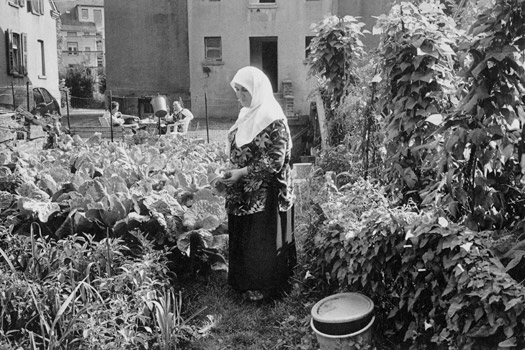
Häuser für zuwandernde Bergleute
Am Rübenkamp in Bochum-Hordel errichteten Bergleute der Zeche Hannover 1890 drei Arbeiterwohnhäuser, die von über einhundert Jahren Zuwanderung zeugen.
© LWL-Industriemuseum Zeche Hannover, Foto Brigitte Kraemer
Leute zurück zur Auswahl
From Stratenhoff to Arslan - Miners homes with a long history
“Von Stratenhoff bis Arslan” was the name of a presentation by the LWL Industrial Museum in 2005: beginning with the first settlers in 1890, who hailed mainly from the Westphalian area, people from a wide variety of backgrounds made their homes in the simple mining houses on the “Rübenkamp”. This was a story of immigration on a small scale; the immigrants’ destination was the Hannover mines. Since 1856, this shaped the development of the Hordel peasantry, when fewer than 200 people lived here. Some fifty years later, there were nearly 5,000 residents. In addition to Westphalia, people came from the Rhineland, and soon after, from Hessen, East and West Prussia, as well as from the Province of Posen, Silesia, and other regions. After 1945, the mine began to attract refugee families and new mining recruits from all over Germany. Beginning in 1970 the last generation of new Hordel residents living in the houses on Rübenkamp was made up of families from Italy, Morocco, and Turkey.
Not until 1905-1911 did the mine purchase three original, identical one-and-a-half story brick houses. In 1890 -1891, these housed one pit foreman as well as two additional miners from the Hannover mine. Two of the owners moved into the owner-occupied homes, which could be reached from the street itself. The tenants reached their rooms using a staircase on the courtyard side of the house. As was then the custom, all the doors to the rented rooms faced out towards the hall and the neighbouring rooms – in this way landlords could create one, or multi-room, tenements. From time to time, an entire family would live in one room. In The Hordel Directory from 1897, there are an average of 10 tenants for each of the three houses, who were then left with 13 square meters of living space. Several of the families also sublet their space to single miners; they would reside in two attic rooms. Stables and large gardens enabled them to farm. This work was generally left to the women, who, in this way, secured the family’s sustenance. For 110 years, the inhabitants brought the horticultural customs of their respective native countries with them. Today, the Industrial Museum displays kitchen gardens such as these, from different eras.
Denkmale zum Impuls
Bochum - Bergmannshäuser in Hordel
Die drei ursprünglich identischen eineinhalbstockigen Backsteinhäuser sind keine ... weiter
Bochum - Zeche Hannover und Siedlung Dahlhauser Heide
Die Schächte der Zeche Hannover in Hordel (heute zu Bochum) wurden ab 1857 abgeteuft; auf ... weiter
